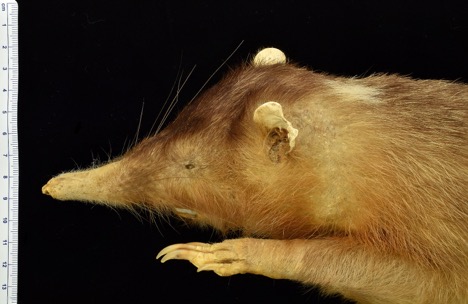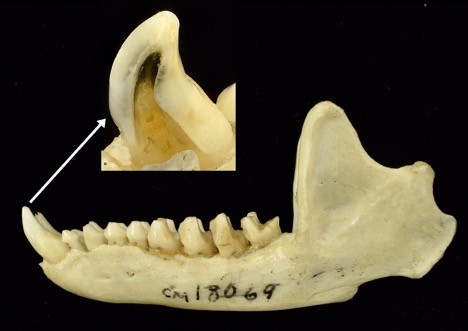

Did you know that some mammals are venomous?
The Section of Mammals has one specimen in its collection of the solenodon, which at 21 inches long is the largest member of the group of mammals that includes shrews and moles.
Our specimen, Solenodon paradoxus, comes from the Caribbean island of Hispaniola (which includes Haiti and the Dominican Republic), but there is second solenodon species in Cuba, Solenodon cubanus. Solenodons have a mobile proboscis, obviously much shorter than an elephant’s trunk, and a powerful sense of smell, which makes up for their tiny eyes. They occupy a shrew-like niche, rooting in leaf litter for insects and earthworms—their primary prey.
Both solenodon species are highly endangered and at various times have been thought to be extinct. Problems for the solenodons started in the 1800s when small Asian mongooses were introduced by humans to control the snake and rat populations; feral dogs and cats aggravated the issue, as the solenodons did not fare well against any of these three carnivores. Habitat destruction has nearly been the final blow.
Prior to the introduction of the carnivores, solenodons were the top mammalian predator on their islands. Part of what helped them was their ability to produce venom in one of their salivary glands, making the solenodon one of the very few venomous mammals. They have a snake-like delivery system for their venom. The tallest tooth in the lower jaw (the second incisor) has a deep groove on its inner surface, which accommodates the duct of the venomous salivary gland. In fact, the name solenodon in Greek means “grooved tooth.” When the solenodon bites, the venom is injected from that tooth and slows down its prey. Unfortunately for the solenodons, their venom and fighting prowess has not been sufficient to protect them from the introduced carnivores.
John Wible, PhD, is the curator of the Section of Mammals at Carnegie Museum of Natural History. John’s research is focused on the tree of life of mammals, understanding the evolutionary relationships between living and extinct taxa, and how the mammalian fauna on Earth got to be the way it is today. He uses his expertise on the anatomy of living mammals to reconstruct the lifeways of extinct mammals. John lives with his wife and two sons in a house full of cats and rabbits in Ross Township.
